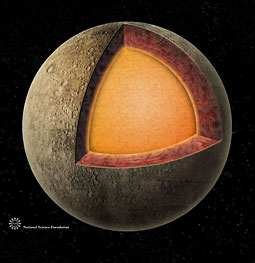
Radar
A team of scientists lead by Jean-Luc Margot, assistant professor of astronomy at Cornell University, has devised a novel method for monitoring the spins of rocky planets from Earth, in order to test some of these theories. They beamed powerful radar signals at Mercury from two separate observatories on the Earth - the NASA Jet Propulsion Laboratory in California, and the Arecibo telescope in Puerto Rico. The echoes of these signals appeared as a unique pattern of speckles, reflecting the roughness of the planet’s surface. Measuring how long it took for a particular pattern of speckles to reproduce at the two earthly monitoring stations – around 10 seconds - allowed the team to calculate Mercury’s spin rate with greater accuracy than has ever been thought possible. The experiment could only produce usable results when the Earth and Mercury stood in a certain alignment, which occurs for periods of just 20 seconds at a time. The scientists made 21 such measurements.
The team also made observations (over five years) to determine Mercury’s libration –tiny twists in the planet’s spin as it orbits the Sun. These occur as a result of Mercury’s eccentric 88-day orbit around the Sun. The Sun exerts forces on the planet causing it to ‘wobble’. The measured librations were double what would be expected for a completely solid body, but fit the idea of a molten core that does not rotate in the same manner as its shell (think of the difference between spinning a hard-boiled egg and a fresh one on a table-top).
The presence of a molten outer core is consistent with dynamo models for generating a magnetic field, but this is not the only viable mechanism for the producing the field. Mercury’s field is very weak – three orders of magnitude less than that of the Earth. An Earth-like dynamo system could operate as a result of several possible configurations of the internal state of the planet. These mysteries may find solutions as future missions arrive at Mercury.
Continuing mission
NASA’s MESSENGER spacecraft is already en route and will fly by Mercury in January 2008 before achieving orbit in 2011. The spacecraft is expected to map the magnetic field in detail and to determine the nature of its source.
In 2013 ESA and Japan’s BepiColombo mission will launch, arriving in 2019. Both of these missions will endeavour to reveal some of the mysteries surrounding Mercury’s magnetic field and interior design, and enable progress in understanding the formation and evolution of an end-member planet. But in the meantime, Margot et al’s novel techniques have provided a new tool to probe planetary interiors from the Earth, opening up avenues in planetary physics to allow us to constrain the underlying geophysical processes of other near by planets.
Ref: Science V 316; 4 May 2007; p 710-714. “Large Longitudinal Libration of Mercury Reveals a Molten Core” J. L. Margot, S. J. Peale, R. F. Jurgens, M. A. Slade, I. V. Holin.